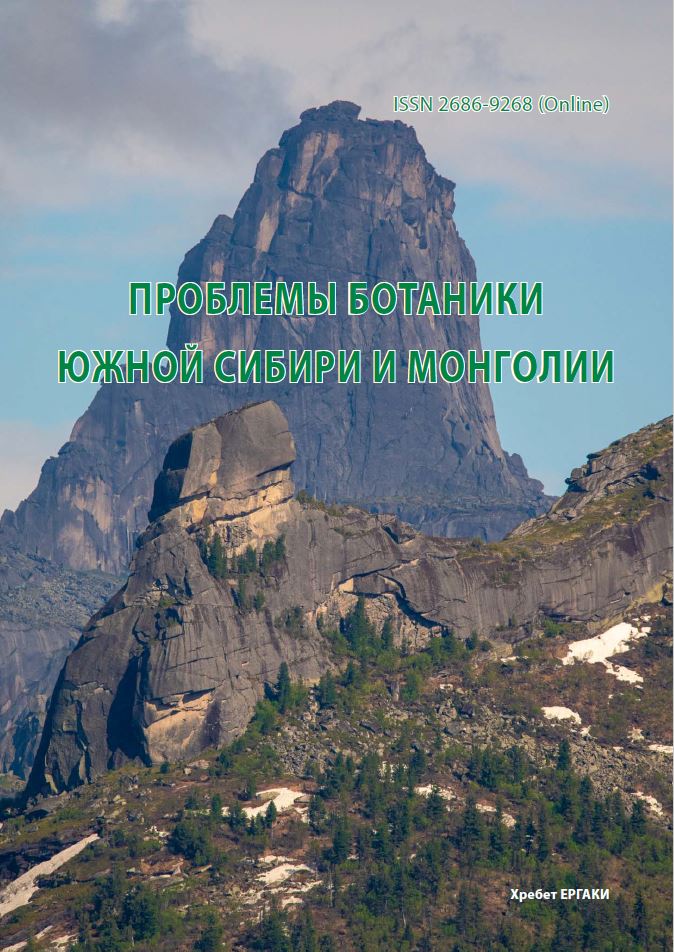The ability to naturalize of the species from the collection “Rare and endangered plant species of Siberia”
УДК 58.006:502.75+58.084.1(571.1/.5)
Abstract
Phytoinvasions can significantly affect the functioning of natural ecosystems. Naturalization of species is the first stage of invasions. Plant introduction is a potential threat to natural ecosystems. The introduction of plants of rare and endangered species is aimed at preserving the biodiversity of the flora, and differs from the cultivation of plants having obvious economic value. The purpose of this study is to determine the species composition of plants on the territory of the collection site ”Rare and endangered plant species of Siberia”, where agrotechnical measures have not been carried out for 20 years. The mosaic of vegetation cover with the introduction of native species was established. 193 species have been identified, of which 55 species are introduced. The restoration of populations of 11 species missing from the collection in 2000 was noted. A 6-point scale for assessing the ability to naturalize introduced species was developed. The analysis of the current species composition showed that 37 species of introduced species (46 %) have disappeared from this territory since 2000. Of the identified introducers, 12 % species are decreasing their numbers, 19 % occupy within the area of cultivation earlier, 23 % of the species spread throughout the territory to varying degrees. At the same time, the ability to naturalize turned out to be unrelated to the type of reproduction of the introduced species. Half of the introducers have adapted to the new environmental conditions, and have gained a foothold in a new ecological niche.
Downloads
Metrics
References
Беляева Н. В., Григорьева О. И., Гуталь М. М. Обилие и константность как показатели участия вида в сложении растительной ассоциации // Актуальные проблемы лесного комплекса, 2009. - Вып. 22. - С. 68-75.
Елисафенко Т. В., Дорогина О. В. Методические рекомендации по интродукции и восстановлению природных популяций редких и исчезающих видов растений. - Кемерово: Примула, 2021. - 48 с.
Определитель растений Новосибирской области. - Новосибирск: Наука, 2000. - 492 с.
Растительное многообразие Центрального сибирского ботанического сада СО РАН. - Новосибирск: Академическое из-во «Гео», 2014. - 492 с.
Редкие и исчезающие растения Сибири. - Новосибирск: Наука, Сиб. отд-ние, 1980. - 223 с.
Семенова Г. П. Интродукция редких и исчезающих растений Сибири. - Новосибирск: Наука, 2001. - 132 с.
Соколова В. В., Хомутовский М. И, Виноградова Ю. К. Инвазионный потенциал растений экспозиции флоры Кавказа в Главном ботаническом саду им. Н. В. Цицина РАН // Российский Журнал Биологических Инвазий, 2022. - Т. 15, № 4. - С. 55-68. DOI: 10.35885/1996-1499-15-4-55-68
Pimental D., McNair S., Janecka J., Wightman J., Simmonds C., O’Connell C., WongE., Russel L., Zern J., Aquino T., Tsomondo T. Economic and environmental threats of alien plant, animal, and microbe invasions // Agriculture, Ecosystems and Environment, 2001. - Vol. 84, Iss. 1. - P. 1-20. DOI: 10.1016/S0167-8809(00)00178-X
Plants of the World Online. URL: https://powo.science.kew.org (Accessed 4 May 2023).



